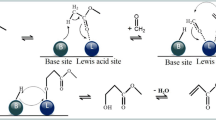Abstract
Crossed vapor-phase aldol condensations are highly selective as the condensation between isobutyraldehyde and acetone shows. Following a publication describing a catalyst system with tin on silica and hydrogen as carrier gas to regenerate the tin continuously, isobutyraldehyde and acetone were reacted to the three isomeres 5-methyl-3-hexen-2-one, 5-methyl-4-hexen-2-one, and 5-methyl-5-hexen-2-one, which can be hydrogenated to methyl isopentyl ketone. Experiments carried out with the catalyst mentioned above in order to optimise this vapor-phase aldol condensation showed that this condensation is a strong temperature depending equilibrium reaction. At a temperature of 350 °C and atmospheric pressure it was not possible to get a yield more than 17 molepercent of the acetone used. Conversion of acetone between 10% and 30% gave rise to yields of 60 and 48 molepercent respectively of the isomeric methylhexenones. The space time yield was 54 g·l−1·h−1.
Zusammenfassung
Am Beispiel der Gasphasenaldolkondensation von Isobutyraldehyd mit Aceton wird gezeigt, daß gekreuzte Aldolreaktionen in der Gasphase selektiver verlaufen können. Unter Verwendung eines erst seit kurzem bekannten Katalysatorsystems mit Zinn auf Kieselgel und Wasserstoff als Trägergas zur dauernden Regenerierung des Zinns wurden Isobutyraldehyd und Aceton in einem Strömungsreaktor zu den drei Isomeren, 5-Methyl-3-hexen-2-on, 5-Methyl-4-hexen-2-on und 5-Methyl-5-hexen-2-on, umgesetzt, die zu Methylisopentylketon hydriert werden können. Diese Gasphasen-aldolkondensation erwies sich bei Optimierungsversuchen mit dem obengenannten Katalysator als stark temperaturabhängige Gleichgewichtsreaktion. Bei 350 °C und Normaldruck ließ sich die Ausbeute an Methylhexenon deshalb nicht über 17 Molprozent des eingesetzten Acetons steigern. Bei Acetonumsätzen zwischen 10% und 30% lag die darauf bezogene Ausbeute bei 60 bzw. 48 Molprozent. Die Raum—Zeit-Ausbeute erreicht 54 g·l−1·h−1.
Similar content being viewed by others
Literatur
I. G. Farbenindustrie, Franz. Pat. 847 370 (26. 6. 1939); Chem. Abstr.35, 51276.
S. Malinowski, H. Jedrzejewski, S. Basinski undS. Benbenek, Chim. Ind. [Paris]85, 885 (1961); Chem. Abstr.56, 2321 g und Rev. Chim. Acad. Rep. Popul. Roumaine6, 5 (1961); Chem. Abstr.57, 11003 i.
Z. Czarny, Chem. Stosowana, Ser.A 7, 609 (1963); Chem. Abstr.62, 6386 g.
F. M. Scheidt, J. Catal.3, 372 (1964).
R. N. Watts, W. J. Porter, J. A. Wingate undJ. A. Hanan, Franz. Pat. 1 344 591, 29. 11. 1963; Chem. Abstr.60, 10551 b.
P. B. Venuto undP. S. Landis, J. Catal.6, 237 (1966).
J. F. Vitcha undV. A. Sims (Air Reduction Co), Ind. Engng. Chem. Quaterlies5, 50 (1966).
H. E. Swift, J. E. Bozik undF. E. Massoth, J. Catal.15, 407 (1969).
S. G. Powell undF. Hagemann, J. Amer. Chem. Soc.66, 372 (1944).
Author information
Authors and Affiliations
Additional information
Herrn Prof.F. Asinger zum 65. Geburtstag gewidmet.
Mit 5 Abbildungen
Rights and permissions
About this article
Cite this article
Droste, W., Obenaus, F. Aldolkondensation von Isobutyraldehyd mit Aceton in der Gasphase. Monatshefte für Chemie 104, 485–495 (1973). https://doi.org/10.1007/BF00903112
Received:
Issue Date:
DOI: https://doi.org/10.1007/BF00903112




